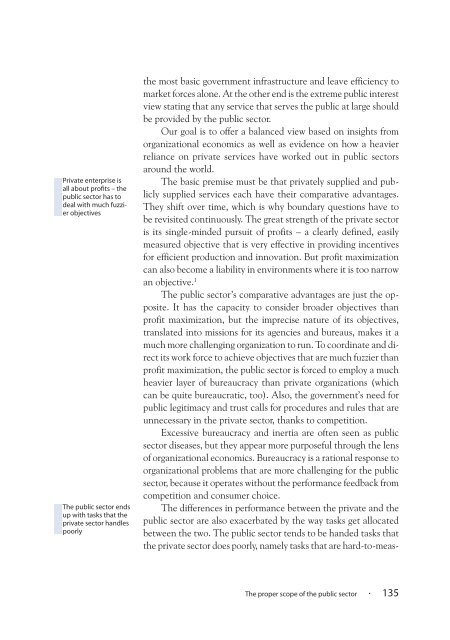The Nordic Model - Embracing globalization and sharing risks
The Nordic Model - Embracing globalization and sharing risks
The Nordic Model - Embracing globalization and sharing risks
You also want an ePaper? Increase the reach of your titles
YUMPU automatically turns print PDFs into web optimized ePapers that Google loves.
Private enterprise is<br />
all about profits – the<br />
public sector has to<br />
deal with much fuzzier<br />
objectives<br />
<strong>The</strong> public sector ends<br />
up with tasks that the<br />
private sector h<strong>and</strong>les<br />
poorly<br />
the most basic government infrastructure <strong>and</strong> leave efficiency to<br />
market forces alone. At the other end is the extreme public interest<br />
view stating that any service that serves the public at large should<br />
be provided by the public sector.<br />
Our goal is to offer a balanced view based on insights from<br />
organizational economics as well as evidence on how a heavier<br />
reliance on private services have worked out in public sectors<br />
around the world.<br />
<strong>The</strong> basic premise must be that privately supplied <strong>and</strong> publicly<br />
supplied services each have their comparative advantages.<br />
<strong>The</strong>y shift over time, which is why boundary questions have to<br />
be revisited continuously. <strong>The</strong> great strength of the private sector<br />
is its single-minded pursuit of profits – a clearly defined, easily<br />
measured objective that is very effective in providing incentives<br />
for efficient production <strong>and</strong> innovation. But profit maximization<br />
can also become a liability in environments where it is too narrow<br />
an objective. 1<br />
<strong>The</strong> public sector’s comparative advantages are just the opposite.<br />
It has the capacity to consider broader objectives than<br />
profit maximization, but the imprecise nature of its objectives,<br />
translated into missions for its agencies <strong>and</strong> bureaus, makes it a<br />
much more challenging organization to run. To coordinate <strong>and</strong> direct<br />
its work force to achieve objectives that are much fuzzier than<br />
profit maximization, the public sector is forced to employ a much<br />
heavier layer of bureaucracy than private organizations (which<br />
can be quite bureaucratic, too). Also, the government’s need for<br />
public legitimacy <strong>and</strong> trust calls for procedures <strong>and</strong> rules that are<br />
unnecessary in the private sector, thanks to competition.<br />
Excessive bureaucracy <strong>and</strong> inertia are often seen as public<br />
sector diseases, but they appear more purposeful through the lens<br />
of organizational economics. Bureaucracy is a rational response to<br />
organizational problems that are more challenging for the public<br />
sector, because it operates without the performance feedback from<br />
competition <strong>and</strong> consumer choice.<br />
<strong>The</strong> differences in performance between the private <strong>and</strong> the<br />
public sector are also exacerbated by the way tasks get allocated<br />
between the two. <strong>The</strong> public sector tends to be h<strong>and</strong>ed tasks that<br />
the private sector does poorly, namely tasks that are hard-to-meas-<br />
<strong>The</strong> proper scope of the public sector · 135

















